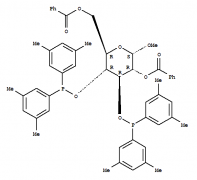- 中文别名:甲基 α-D-吡喃葡萄糖苷-2,6-二苯甲酸甲酯-3,4-双(3,5-二甲苯基)磷酸盐
- 中文释义:甲基 Alpha-D-吡喃葡萄糖苷-2,6-二苯甲酸甲酯-3,4-双(3,5-二甲苯基)磷酸盐;甲基 Α-D-吡喃葡萄糖苷-2,6-二苯甲酸甲酯-3,4-双(3,5-二甲苯基)磷酸盐
- 英文别名:Methyl a-D-glucopyranoside-2,6-dibenzoate-3,4-di(bis(3,5-dimethylphenyl)phosphinite), min. 95% CARBOPHOS;
CARBOPHOS - cas No.:158214-06-3
- 分子式:C53H56O8P2
- 分子量:882.98
- 精确分子量:882.34500
- PSA:116.70000
- 分子结构式:

物化性质
- 熔点:
- 162-164ºC
- 其它信息:
1. 性状:未确定
2. 密度(g/mL,20℃):未确定
3. 相对蒸汽密度(g/mL,空气=1):未确定
4. 熔点(ºC):162-164
5. 沸点(ºC,常压):未确定
6. 沸点(ºC 130mmHg):未确定
7. 折射率:未确定
8. 闪点(ºF):未确定
9. 比旋光度(º):未确定
10. 自燃点或引燃温度(ºC):未确定
11. 蒸气压(kPa,25ºC):未确定
12. 饱和蒸气压(kPa,60ºC):未确定
13. 燃烧热(KJ/mol):未确定
14. 临界温度(ºC):未确定
15. 临界压力(KPa):未确定
16. 油水(辛醇/水)分配系数的对数值:未确定
17. 爆炸上限(%,V/V):未确定
18. 爆炸下限(%,V/V):未确定
19. 溶解性:未确定
安全信息
- 熔点:
- 162-164ºC
- 其它信息:
1. 性状:未确定
2. 密度(g/mL,20℃):未确定
3. 相对蒸汽密度(g/mL,空气=1):未确定
4. 熔点(ºC):162-164
5. 沸点(ºC,常压):未确定
6. 沸点(ºC 130mmHg):未确定
7. 折射率:未确定
8. 闪点(ºF):未确定
9. 比旋光度(º):未确定
10. 自燃点或引燃温度(ºC):未确定
11. 蒸气压(kPa,25ºC):未确定
12. 饱和蒸气压(kPa,60ºC):未确定
13. 燃烧热(KJ/mol):未确定
14. 临界温度(ºC):未确定
15. 临界压力(KPa):未确定
16. 油水(辛醇/水)分配系数的对数值:未确定
17. 爆炸上限(%,V/V):未确定
18. 爆炸下限(%,V/V):未确定
19. 溶解性:未确定
MSDS
- Section 1: Product Identification
Methyl alpha-D-glucopyranoside-2,6-dibenzoate-3,4-di(bis(3,5-dimethylphenyl)phosphinite), min. 95%
Chemical Name:
CARBOPHOS
CAS Registry Number:158214-06-3
Formula:C53H56O8P2
EINECS Number:none
Chemical Family:organophosphine ligand
Synonym:CARBOPHOS
Section 2: Composition and Information on Ingredients
IngredientCAS NumberPercentACGIH (TWA)OSHA (PEL)
Title Compound158214-06-3100%no datano data
Section 3: Hazards Identification
Emergency Overview:Irritating to the respiratory tract, skin and eyes. May be harmful if swallowed.
Primary Routes of Exposure:Ingestion, inhalation
Eye Contact:Causes slight to mild irritation of the eyes.
Skin Contact:Causes slight to mild irritation of the skin.
Inhalation:Irritating to the nose, mucous membranes and respiratory tract.
Ingestion:No information available on the physiological effects of ingestion.
Acute Health Affects:Irritating to skin, eyes and respiratory tract.
Chronic Health Affects:No information available on the long-term effects of overexposure.
NTP:No
IARC:No
OSHA:No
SECTION 4: First Aid Measures
Immediately flush the eyes with copious amounts of water for at least 10-15 minutes. A victim may need
Eye Exposure:
assistance in keeping their eye lids open. Get immediate medical attention.
Wash the affected area with water. Remove contaminated clothes if necessary. Seek medical assistance if
Skin Exposure:
irritation persists.
Remove the victim to fresh air. Closely monitor the victim for signs of respiratory problems, such as difficulty
Inhalation:
in breathing, coughing, wheezing, or pain. In such cases seek immediate medical assistance.
Seek medical attention immediately. Keep the victim calm. Give the victim water (only if conscious). Induce
Ingestion:
vomiting only if directed by medical personnel.
SECTION 5: Fire Fighting Measures
Flash Point:no data
Autoignition Temperature:none
Explosion Limits:none
Extinguishing Medium:carbon dioxide, dry powder or foam
If this material is involved in a fire, fire fighters should be equipped with a NIOSH approved positive pressure
Special Fire Fighting Procedures:
self-contained breathing apparatus and full protective clothing.
Hazardous Combustion andIf involved in a fire this material may emit toxic organic fumes.
Decomposion Products:
Unusual Fire or Explosion Hazards: No unusual fire or explosion hazards.
SECTION 6: Accidental Release Measures
Spill and Leak Procedures:Small spills can be mixed with vermiculite or sodium carbonate and swept up.
SECTION 7: Handling and Storage
Store in a tightly sealed container. Keep away from heat and direct sunlight. Prolonged contact with the
Handling and Storage:
atmosphere may result in degradation of the product.
SECTION 8: Exposure Controls and Personal Protection
Eye Protection:Always wear approved safety glasses when handling a chemical substance in the laboratory.
Skin Protection:Wear protective clothing and gloves.
Ventilation:If possible, handle the material in an efficient fume hood.
If ventilation is not available a respirator should be worn. The use of respirators requires a Respirator
Respirator:
Protection Program to be in compliance with 29 CFR 1910.134.
Ventilation:If possible, handle the material in an efficient fume hood.
Additional Protection:No additional protection required.
SECTION 9: Physical and Chemical Properties
Color and Form:white pwdr.
Molecular Weight:882.98
Melting Point:162-164°
Boiling Point:no data
Vapor Pressure:no data
Specific Gravity:no data
Odor:none
Solubility in Water:insoluble
SECTION 10: Stability and Reactivity
Stability:air sensitive solid
Hazardous Polymerization:no hazardous polymerization
Conditions to Avoid:prolonged contact with air
Incompatibility:oxidizing agents, halogens and oxygen.
Decomposition Products:carbon dioxide, carbon monoxide, phosphorus pentoxide, and organic fumes.
SECTION 11: Toxicological Information
RTECS Data:No information available in the RTECS files.
Carcinogenic Effects:No data available
Mutagenic Effects:No data available
Tetratogenic Effects:No data available
SECTION 12: Ecological Information
Ecological Information:No information available
SECTION 13: Disposal Considerations
Disposal:Dispose of according to local, state and federal regulations.
SECTION 14: Transportation
Shipping Name (CFR):Non-hazardous
Hazard Class (CFR):NA
Additional Hazard Class (CFR):NA
Packaging Group (CFR):NA
UN ID Number (CFR):NA
Shipping Name (IATA):Non-hazardous
Hazard Class (IATA):NA
Additional Hazard Class (IATA):NA
Packaging Group (IATA):NA
UN ID Number (IATA):NA
SECTION 15: Regulatory Information
TSCA:Not listed in the TSCA inventory.
SARA (Title 313):Title compound not listed.
Second Ingredient:none
SECTION 16 - ADDITIONAL INFORMATION
N/A
分子结构与计算化学数据
计算化学数据
1、 疏水参数计算参考值(XlogP):0.4
2、 氢键供体数量:3
3、 氢键受体数量:3
4、 可旋转化学键数量:3
5、 互变异构体数量:
6、 拓扑分子极性表面积(TPSA):74.2
7、 重原子数量:19
8、 表面电荷:0
9、 复杂度:335
10、同位素原子数量:0
11、确定原子立构中心数量:0
12、不确定原子立构中心数量:1
13、确定化学键立构中心数量:0
14、不确定化学键立构中心数量:0
15、共价键单元数量:1